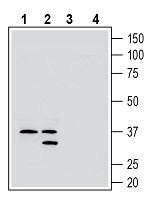Overview
- Peptide (C)KDIKEKSNVG(S)MEFK, corresponding to amino acid residues 155 - 169 of mouse GPR171 (Accession Q8BG55). 2nd extracellular loop.
- Rat and mouse brain membranes; human MEG-01 megakaryoblastic leukemia cell, and Jurkat T-cell leukemia cell lysates (1:200-1:1000).
 Western blot analysis of rat brain membranes (lanes 1 and 3) and mouse brain membranes (lanes 2 and 4):1, 2. Anti-GPR171 (extracellular) Antibody (#AGR-054), (1:200).
Western blot analysis of rat brain membranes (lanes 1 and 3) and mouse brain membranes (lanes 2 and 4):1, 2. Anti-GPR171 (extracellular) Antibody (#AGR-054), (1:200).
3, 4. Anti-GPR171 (extracellular) Antibody, preincubated with GPR171 (extracellular) Blocking Peptide (#BLP-GR054).
- Human live intact Jurkat T-cell leukemia cells (5 µg).
G protein-coupled receptor 171 (GPR171) is an orphan G-protein coupled receptor (GPCR) activated by BigLEN; one of the most abundant neuropeptides in the brain that is derived from ProSAAS1. GPR171 contains seven transmembrane domains, an extracellular N-terminus and an intracellular C-terminal tail. Its detailed structure and ligand binding domain structure was predicted by homology modeling based on its similarity to P2Y12 receptor2,3.
BigLEN–GPR171 neuropeptide-receptor system is expressed in the brain, at the basolateral amygdala (BLA) and the periaqueductal gray brain area4-6.
This system plays an important role in regulating feeding-related behaviors, food intake and body weight regulation. It is also involved in anxiety behavior and various psychiatric disorders4,5.
Furthermore, BigLEN-GPR171 are expressed in GABAergic neurons within the periaqueductal gray, a key brain area involved in pain modulation and opioid functions6.
GPR171 is a potential target for drug development in obesity and weight problems, anxiety, various psychiatric disorders and pain.
